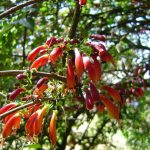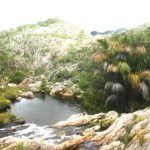TREE LIFE
July 1995
All members of the Tree Society would like to offer their congratulations to Mr. Thomas Muller on being awarded an Honorary Doctorate by the University of Zimbabwe, in recognition of his outstanding and distinguished service to the country.
MASHONALAND CALENDAR
Saturday 1st July: Botanic Garden Walk at 1045 to 1100 hours. We will meet Tom in the public car park of the Gardens, where there will be someone to guard the cars. Tom will continue with the popular subject Acacias.
July 14th, 15th and 16th: The Aloe, Cactus and Succulent Society are holding their Annual show at the Mukuvisi Woodland. In addition to the usual plant sale there will be several stalls selling the popular sunbird feeders, dried flowers, Aloe vera cosmetics, etc. Meg Coates Palgrave has consented to open the Show and present the cups at 1000 hours on Saurday 15th July.
Sunday 16th July: Into the tricky season again, when it is difficult to find suitable venues for our monthly outings. On the recce to Mr. R. Gilmoour’s Oldlands Farm we found sufficient of interest along a small stream, around a dam and on the slopes of a gentle kopje to keep us happy for a day.
Saturday 29th July: Werner Fibeck will be presenting a slide show on the indigenous orchids of Zimbabwe at the lecture hall at St. George’s College a 1400 hours. This will be an excellent opportunity to learn about that fascinating genera Orchidaceae. Werner’s slides are superb and audience participation in the form of discussion and questions will be encouraged. Tea will be served mid way. We invite donations to cover the cost of teas and a thank you to St. George’s for the use of the hall. Although the show may be over by then, please remember that Chancellor Avenue is closed at 6.
Saturday 5th August: Botanic Garden Walk
MATABELELAND CALENDAR
Sunday 2nd July: Aloes in the NATA District. Depart from Girls College Car Park promptly at 0830 hours.
Extra: Continuing with David Attenborough’s ‘The Private Life of Plants’ on the 2nd Monday of each month at 1945 for 2000 at Girls College. The next, on Monday 10th July will be episode 2 – Growing.
Sunday 6th August and Sunday 3rd September: Focus on Combretaceae in and around Bulawayo.
BOTANIC GARDEN WALK, 3RD July 1995
Acacias, Part 2. This month Tom showed us two groups of species of Acacia, namely:
- a) species with curved thorns in pairs, or three, at each node, already partly dealt with last month, and
- b) Species with curved thorns scattered irregularly along the stem, not in pairs at each node.
Firstly, Tom arranged the group a) species in approximate order of leaflet size, starting with the species with small leaflets and more numerous pinnae and ending with large leaflets and few pinnae, as follows : polyacantha, galpinii, hereroensis/fleckii/erubescens, goetzei/welwitschii/ burkei, nigrescens/mellifera.
Acacia goetzei is a proper woodland Acacia. Two varieties exist, var. goetzei, the commoner, but var. microphylla with narrow, 3mm wide, leaflets, can occur anywhere in the range of the species.
Acacia welwitschii and Acacia burkei are very closely related to and difficult to separate from A. goetzei. Acacia welwitschii is hairless and occurs in the SE lowveld, especially common lining streams, e.g. in the area from Chiredzi towards the Save River. Acacia burkei has hairy leaves, also occurs in the SE lowveld, but its habitat is woodland, never along streams.
We looked at a specimen of Acacia nigrescens with an exceptionally knobby trunk. The knobs are particularly prominent on young branches but eventually fall off so that often none are to be found on large mature trunks. It is interesting to note that knobs also occur occasionally on the trunks of: erubescens, galpinii, goetzei, nigrescens and polyacantha, all of which belong to group a) as defined above.
On to group b) with curved scattered thorns. Of the 6 species in Zimbabwe, 3 have flowers in spikes, ataxacantha, chariessa and eriocarpa and 3 in spherical inflorescences, adenocalyx, pentagona and schweinfurthii.
We first looked at Acacia adenocalyx, which has only been recorded from Mudzi District where it was only recently recognized as this species.
Acacia ataxacantha is a much commoner species, occurring in the jesse, especially degraded parts of it, and on Kalahari Sand. It is not usually in riverine habitats, as is schweinfurthii. It may be a climber or a tree. Acacia schweinfurthii is usually riverine and is a climber, scrambler or liane.
One problem quite frequently encountered in the Central Division is separating schweinfurthii from ataxacantha. Strangely, no books ever seem to mention that is a problem! A number of characters were suggested: if the plant is flowering, then separation is easy because of the difference in inflorescence shape. If in fruit, the arrangement of the fruit is helpful, fruits arise along the line of the original flower spike in ataxacantha and from the same point in schweinfurthii. If in leaf only, as they usually are, it is much more difficult. Acacia schweinfurthii has a relatively large pulvinus, relatively larger leaves, the gland on the petiole is in the lower third of the petiole, further up in ataxacantha; schweinfurthii often has the thorns arranged in different coloured longitudinal bands along the stem, but ataxacanatha may also, and a clue may be given by the habitat and form of the plant, as mentioned above. However, we have seen the two species flowering side by side in riverine forest at Sanyati.
Acacia chariessa is an indicator of pyroxenite. Usually a shrub, it is particularly common but not confined to the Dyke. Acacia eriocarpa is another shrub. It occurs on anthills in the Zambezi Valley, its leaves are exceptionally large and it has enormous stipules. These had, however, already fallen off the specimen in the Gardens.
Acacia pentagona is very like schweinfurthii but occurs as an enormous liane in evergreen forests, e.g. Chirinda Forest.
Finally, we looked at Acacia senegal, which was already dealt with by Andy MacNaughtan last month. Incidentally, Bob Drummond suggests that the two varieties of Acacia senegal, namely var. leiorhachis and var. rostrata should be reinstated to separate species.
Our great thanks to Tom for an immensely stimulating discussion of Acacias.
-Mark Hyde
TEMPLETON ESTATE, 22ND May 1995
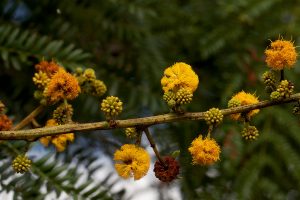
Acacia amythethophylla. Photo: Mark Hyde. Source: Flora of Zimbabwe
With the AGM over, Anne suggested a walk down to a patch of riverine not far from the homestead. Being on the fringe of the Highveld and only a few km from the dyke meant a likely chance of finding something different. Passing between the two kopjes crowned with Euphorbia ingens we came under a line of Brachystegia boehmii used by a resident group of vervet monkeys as a highway between the kopjes. Nearer to the river we passed a Ficus sycomorus with a large pale yellow buttress bole and other characteristic pale trunks belonging to Acacia polyacantha. Other Acacias noted were Acacia nilotica in thickets along with its typical segmented fruit, A.goetzei and the droopy-leaved A. amythethophylla. Many spiny thickets of Dalbergia melanoxylon, the result of previous cutting for Bagpipe chanters, were painfully obvious as the straight spines masked by the rounded leaflets raked our hands and heads as we had missed the well-worn path. Suddenly the thickets gave way to a superb tranquil scene with palms, Phoenix reclinata curving gently upwards towards the canopy of Syzygium guineense that followed the water course. Deep within the shade Ficus sur with unusually large leaves were heading for say direct sunlight while in the camp crevices various ferns and mosses thrived. A deeply buttressed bole of a waterberry, which must have fallen over years ago and then continued its skyward path, was home to a small Ficus. Probably the more usual F.thonningii, but the odd shaped leaves were an excuse to probe the possibility of Ficus nigro punctata.
A short distance away the riverine gave way to some more Acacias and then drier sandveld which had some fruiting Ximenia americana, Sue du Plessis’ face a picture as she bit into the fruit and tested the stringent qualities. Behind the kopje anchored in the rocks we found the F.cordata that Anne had spoken about earlier. Large and spreading the densely packed spear like leaves made a patch of deep shade. From here looking up the kopje we added Sterculia quinqueloba and a couple of Commiphoras, C.mollis and C.marlothii to the list. A dry throat did not hamper Miles Standish White’s rendering of Azanza garckeana in Ndebele which to the average ear sounded like boo-klacku-klacku’, tongue and teeth operating in harmony to produce the clicks!
On the kopje the various Brachystegia glaucescens and on a lower rock face the pale trunk of Albizia tanganyicensis and the firebush Hymenedictyon floribundum, which guarded the gents bush toilet, brought our total to 76 species. Anne’s nursery was a delight to wander through and various members were seen later in the afternoon peering out from the foliage which filled the inside of their cars.
Anne and Nino, thank you for making the day such a success and for all the preparations you went to for us. As always, a wander through your nursery and the lunchtime soup made the day really enjoyable.
-Andy MacNaughtan
LUMENI FALLS
There is a painting by Gustav Courbet entitled “Stream in a Ravine”, a splendid landscape, full of the deepest solitude. The original hands in the Louvre and I am lucky enough to have a small print of this ravishingly beautiful picture. It is a riot of luminous and luxuriant vegetation, dark and forbidding rocks, sombre pools and sparkling ripples. I look at it and the valleys of the Matopos are evoked and when we went to Lumeni Falls on Sunday 4th I walked in Courbet’s picture.
This was to be a second visit to the area. A couple of years ago a throng of about three dozen and a convoy of at least fifteen vehicles spent the morning above the falls. On this occasion ten of us in three vehicles made the approach from the downstream side.
It was one of the mild and perfect days which make late May and early June so exhilarating in the Matopos, with a brilliant sky, scudding clouds and enough of a breeze to deter the Mopane bees. A roughish track from the gravel road led us through neat villages and aloe gardens ablaze with Chabaudiis in full bloom to the Lumeni River. Despite the appalling drought, the few late rains have been sufficient to sustain a crystal clear flow in the stream that meanders over white sands away from the rock fall and pools at the base of the falls. Hills rise steeply on either side. To the east the blue-green of Brachystegia glaucescens woodland is broken by the shimmering greys of substantial stands of Olea europaea. The western flanks are rockier and petrophytes abound. Within a small area whose radius was no more than 20 m I saw Ficus ingens, Ficus glumosa and Ficus tettensis and arising from deeper soils in the fissured granite observed specimens of Euphorbia cooperi and E.ingens and Commiphora marlothii. Such was the diversity of the valley floor, however, that we paid only scant attention to the slopes preferring to concentrate our efforts on the riverine and river terrace vegetation.
The riparian vegetation is dense and tangled with an unexpected assortment of subjects forming the upper storey of the gallery forest. Faurea saligna and Terminalia sericea were amongst the unexpected and all were exceptionally large specimens. However, one was not surprised to find Apodytes dimidiata, Diospyros mespiliformis, Ficus sur or Parinari curatellifolia. The latter smelling like a sewer. The middle levels are occupied by some of the largest Artabotrys brachypetalus I have ever seen and by numerous Antidesma venosum which were dropping flowers and setting fruit.
The river terraces present a manicured picture where closed-cropped couch grass is dotted with Albizia amara, Pseudolachnostylis maprouneifolia and Ozoroa insignis amongst others. It could have been a golf course.
On our way home we stopped to admire a two-acre hillside stand of blazing Aloe chabaudii, one specimen of which had twenty-four flower heads. It was a wonderful day; we came away with a recording of 98 specimens and notes on a further six.
-Ian McCausland
RIFA 25.5.95
Soon after leaving Maringora the first spectacular views of the Zambezi Valley came into sight. Perhaps this was the cause of an accident which led to a truckload of mealie meal coming to grief on a corner. An enormous troop of baboons had taken advantage of the situation and were stuffing themselves from the spillage. We counted over a hundred, from tiny babies to huge ‘dog’ acting as sentry, before heading down the escarpment towards Chirundu. Rifa, which is situated some 5 km west of the village, was welcoming with dormitories on the left of the ‘dining hall’ and the ‘cosy pads’ on the right. The whole camp was shaded by large Tamarinds and a spectacular Ficus bussei, with surrounding Mopane woodland. The Zambezi River was visible to the right while the old floodplain and banks with resident groups of Faidherbia albida were right in front of the camp.
Once we unpacked we headed for a dry river bed where Leslee Maasdorp had noted some flora to whet our appetites. Hunters Alec and Rob along with scout Derrison, formed an armed escort as this area normally contains buffalo and lion, also the Tree Society is not noted for speed. Early on in the walk, Leslee pointed out a mopane covered in elephant dung – a pachyderm road sign. This was an area of ‘different plants’ such as Maerua edulis, a Capparaceae commonly called a ‘rats wee bush’ as the sap has a pungent foul smell, and the legendary Torch wood, Balanites maughamii. The ones we saw towered on buttressed smooth trunks which supported leafy crowns full of massive green forked spines. This tree has the vernacular name thorns as having a connection with the development of female breasts. Bubayamhdoro, to hold back the lion, which is also used for several Acacia species and can lead to some confusion. One of the traditional used of the timber is for spear shafts. The Annonaceae are prized for their fruit but from Artabotrys brachypetalus fishing hooks have been produced from the ‘hook stumps’. A very exciting find was Cleistochlamys kirkii, a medium-sized multi-trunked tree with an attractive peeling bark and the crushed leaves had an interesting sweet resinous smell. Years ago according to our scout, certain traditional societies regarded the knobby basis of Acacia nigrescens as having a connection with the development of female breasts. For this reason a girl entering puberty would string a couple of wooden beads on a cord and place them on a knobby branch hoping tat in due course her efforts would be rewarded. Some of the trees of note were Combretum kirkii, liane like with a thick white knobby stem heading up into the canopy trees, huge Commiphora caerulea, leafless and with a blue green peeling bark. Nearer the stream Cordia mukuensis with superb fluted smooth grey trunks and the canopies formed by the Nyala berry, Xanthocersis zambesiaca. A line of red sandstone cliffs, followed the seasonal streams course and here we found an avian time share! During winter Horus Swifts occupy the nesting holes and in summer Bee Eaters take their place. After a walk down to the river we returned to the camp via the flood plain and its swathes of Adrenalin grass!
-Andy MacNaughtan
Friday 26th May
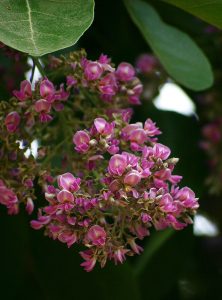
Lonchocarpus capassa. Photo: Bart Wursten. Source: Flora of Zimbabwe
Early in the morning, under the guidance of Leslee Maasdorp we set off down the road from the camp. We examined the clearly marked footprints in the soft sands; hyena, buffalo, elephant. The road ran alongside the flood plain of the dried-up Rifa river and was shaded by large trees, including Trichilia emetica, Tamarindus indica and Lonchocarpus capassa. Leslee pointed out to us the Green Pools supporting masses of floating aquatics and we walked down to the Hot Springs where only Blue-green algae could survive in the scalding sulphurous water. Then we climbed a kopje using a path through Combretum elaeagnoides and Acacia ataxacantha. Leslee showed us a superb specimen of Ficus abutilifolia, with its long rock-splitting root in its crevice, reaching down a cliff and its large, heart shaped leaves and smooth, greenish-yellow branches standing out against the blue sky.
Our next highlight was an enormous hollow baobab, Adansonia digitata. The two children in the party scrambled with ease through a triangular opening in its side and Andy followed with less ease. They found themselves in a large, cylindrical ‘cave’ with smooth walls and no apparent roof.
At the top of the kopje we were shown an Entandrophragma caudatum tree, with its attractive flaking bark. Among the rocks around its base there was a strongly marked but well camouflaged tortoise, ‘probably hibernating’.
We returned to camp and after a superb breakfast we set out again; this time through Colophospermum mopane woodland with undergrowth of Combretum mossambicense and C.elaeagnoides, and Boscia mossambicensis and B.matabelensis. Our destination was a tranquil pan ringed with large trees including Lecaniodiscus fraxinifolius and Diospyros mespiliformis. In places, animals had rubbed against the Diospyros trunks exposing the black ebony wood.
In the afternoon we used the vehicles to reach a point upstream on the banks of the Zambezi. On the way we stopped to admire a grove of large Croton megalobotrys trees. When we arrived near the river we started walking through scrubland with Acacia tortilis, Flueggea virosa, more Boscia mossambicensis and B.matabelensis, and Capparis tomentosa. Then the scrub gave way to the tall trees of the riverine forest including Faidberbia albida as well as Lonchocapus capassa, Tamarindus indica and Trichilia emetica. There were hippos in the river, waterbuck on an island and several species of birds. It was a beautiful and tranquil place.
-Sybil Duncanson
Saturday 27th May
Saturday began with tea and biscuits and a quick walk to the river. John Cotterill gave us a pointer on the Boscia – the Portuguese being smoother, (Boscia mossambicensis smooth leaf) then the matabeles (no offence to the Matabeleland Branch), Boscia matabelensis, rough leaf. We walked through predominantly Lonchocarpus capassa woodland and wondered if this would be the dominant tree in the valley in the future. So much to see and learn . . . . .
Ximenia is seldom found on its own, it is thought to be a root parasite. The new growth of Diospyros mespiliformis is a bright red. Two huge creepers were entwined and growing up a Faidherbia albida. One with a very woody stem, smooth bark and leaves 5 veined from the base. Mark enlightened us with Cocculus hirsutus and a Combretum microphyllum with brown flaky bark.
The potato smell by the river was very strong and plenty of shrubby Phyllanthus in flower were found.
While we admired the view of the fast-flowing river 3 ground hornbills flew past in the trees behind us. Returning, we saw army ants marching in procession all carrying white ants except the soldier ants who were ready for attack.
Plenty of Kigelia africana but no fruit, eaten by baboons? The hunters thought so. After an enormous breakfast, we headed for the Sharu River through thickets of Karomia tettensis with the Chinese hats all nicely dried on the plant. A bit of bad judgment from Bob Maser as he got stuck in the sandy river bed and more to learn.
Combretum elaeagnoides with its grey new growth tips.
Gardenia resiniflua was very hairy and quilted
Commiphora caerulea – flaky peeling paper and blue/grey underbark
Croton menyhartii was very similar to C.gratissimus but very rough on the upper surface. Quite strange through a lens, like fluffy white mountains.
Bushbuck Alley for tea? No, we would return here for lunch—meanwhile a walk to a huge Ficus bussei through heavily grazed Triplochiton so as to be only shrubs. Maureen sorted out the Sterculia for us, S.africana, bigger, 3-5 lobed fruit with seeds hanging out and smaller leaf. S.quinqueloba with large 5 lobed leaf and smaller fruit. Karl pointed out a Solifugit, the sun spider, not a true spider. And, suddenly, in the heat of the day the sweet and strong perfume of B.mossambicense in full flower. Acacia robusta with paired straight thorns and the membranous sickle shaped pod and back to the shade for delicious rolls p.k.f. Merryl and tea made in the bush microwave by Alex.
A quick walk through the magnificent shady wood. Huge stands of Balanites maughanii, Cordyla, Xanthocercis, Tamarind, Acacia nigrescens and shrubby Friesodielsia. Just like a park and so peaceful. Home via a pan and how worthwhile. A kudu bull and his harem came down to drink. The hunters said he needed another twist to his horns to be a trophy, but he was beautiful. He spent quite some time dragging his horns through the mud as though trying to remove an irritant, but no one knew the reason for this. We watched for a good while to the background sounds of ‘gotcha-gotcha’ and ‘casscara casscara’ and took in the ele that came down for a drink, the Egyptian geese, black winged slilts and Meyer’s parrots flying over furiously shrieking. The boys played in the elephant footsteps deeply imprinted in the bud while the boffins botanized.
A lovely end to the day. A big thank you to all the organizers for an excellent weekend in a wonderful place.
Sue du Plessis
Sunday 28th May
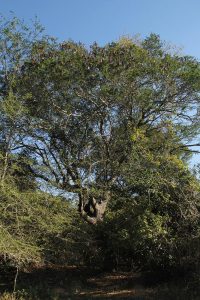
Newtonia hildebrandtii. Photo: Bart Wursten. Source: Flora of Zimbabwe
We began the day by visiting the Tiger Safaris headquarters, downstream on the banks of the Zambezi. The well-kept grounds contained many large trees. One of the most interesting species was Newtonia hildebrandtii, with its fern-like leaves and long red pods. A large Albizia amara grew on an anthill. Also present were Acacia robusta, Cordyla africana, Ficus bussei and Garcinia livingstonei.
In our next walk, we explored the riverine fringe forest on the banks of the dry Chipandaura river. Here, there was also a wealth of large and beautiful trees, including Balanites marghamii, Lannea schweinfurthii, Pterocarpus lucens, and Xeroderris stuhlmannii. Smaller trees included Diospyros senensis, Gardenia resiniflua, Cadaba kirkii and the fascinating paddle pod tree, Hippocratea parviflora.
We returned to camp by contouring high on a rocky ridge. There were several attractive specimens of Kirkia acuminata, but the highlight was a propeller tree, Gyrocarpus americanus. It was leafless, so the very white smooth bark showed up dramatically.
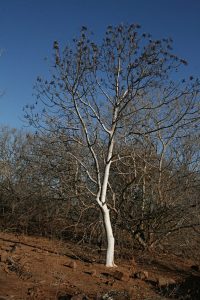
Gyrocarpus americanus. Photo: Bart Wursten. Source: Flora of Zimbabwe
In the afternoon we went down to the Zambezi again. This time, we took folding chairs, sundowners and snacks and watched a spectacular sunset with its colours reflected on the smooth surface of the water.
At dinner, there was a surprise. Our caterer, Merryl Rautenbach, had made and iced a birthday cake for Maureen, complete with a green and brown icing sugar tree, Bob presented Maureen with a book she had long wanted, ‘The Mukamba Tree’, not only as a birthday present but a so as a token of appreciation of all Maureen’s sterling work for the Tree Society.
Sybil Duncanson
Monday 29.05.95
To round off our Rifa trip Leslee took us to the old floodplain upriver from the camp. Near the river bank and on the edge of the Combretum thicket we stumbled on a colony of large black ants. Once aware of a human presence the ants exploded into action attacking shoes, socks and legs! What they were feeding on seemed to be some insect larvae which were being hauled off into a nearby burrow. A feature of this area has been the development of mainly Lonchocarpus capassa woodland, since the flow pattern was altered by the construction of Kariba with a few Kigelia africana now and then for variety. The shallow flooding of the plain at periods of peak power generation caused little disturbance to the vegetation and the moist surrounds kept Mark busy for a few minutes but even so the usually bulging bags were thin. Termites of a species restricted to the valley had constructed lop-sided mounds about the plain and river banks. Superbly adapted to the heat these mounds had a smoothly curved surface facing the more gentle morning sun and a flatter cum vertical face towards the full blast of the westering sun. As an added control a vent near the top can be closed with mud or broken open to suit the ambient temperatures. Of the 90 or so termite species in Zimbabwe only the more specialized make mounds and as with bees the type of food often a fungus given to the nymphs control what caste they become, soldiers, workers or primary reproductive. These ‘primaries’ are the ‘flying ants’ that appear with the first rains and after the first flight etc. both male and female tend their broods until the colony is large enough to support workers which then take on ‘domestic duties’.
In the late 1940’s a test site was cleared near Rifa for the Chirundu Sugar Project. Evidently successful as the main estates were established downriver some years later and the worked-out soil left for nature to reclaim. The undisturbed perimeter was defined by tall Kirkia acuminata and Mopane while the regeneration consisted of Acacia ataxacantha thickets, some Strychnos madagascariesis and Croton megalobotrys. The Acacia lived up to its vernacular name which means ‘come back again; by snagging clothes and limbs regularly and the scout said that sores caused by the prickles often turn septic. Too soon we found ourselves heading home but were delayed by the presence of the python-like climber Fockea multiflora, its real name, and the Brachystegi allenii at Maringora. A wonder trip and many thanks to Merryl and Cindy for the catering. Alec and Rob for escorting us and Leslee for showing us the special parts of the area. Maureen and Bob, many thanks for getting the idea together and organizing the trip to this fascinating area.
-Andy MacNaughtan
Through the eyes of a junior member, extracts from Robert Hyde’s Rifa Diary
1st Day at Camp: We had problems to get to Rifa because our Land Cruiser got air in the fuel line. We had to tow it home. On the Zambezi Escarpment we saw some baboons at the side of the road eating flour. The flour came off a truck. Further down we saw some elephants eating a bush. On a dust road we saw two lions crossing the road.
2nd Day at Camp: I got up early and had a walk in the bush with three hunters. We saw some hot springs, an open tree which you can go in, and I was shown a gun. After that we went to the Zambezi River. I played in the sand and found horns. When we got back it was dark.
3rd Day at Camp: We went to a cliff. On the road we saw a tree trunk that was hollow. We went to Long Pan ad saw a kudu bull, 3 kudu cows and an elephant. Then we went home.
4th Day at Camp: We went on a long hot walk in the morning. We saw an elephant. Some of us came home early while the others climbed the hill for more trees. In the afternoon on the flood plain we saw elephants, hippo, jackal, impala, bushbuck, baboons and a fish eagle’s nest. We watched the sun set from the river bank cliff. In the evening we saw 4 hippo in the spot light and looked at stars. I know the Southern Cross, Scorpio, The False Cross and Corvus the Crow.
ANDY MACNAUGHTAN CHAIRMAN


